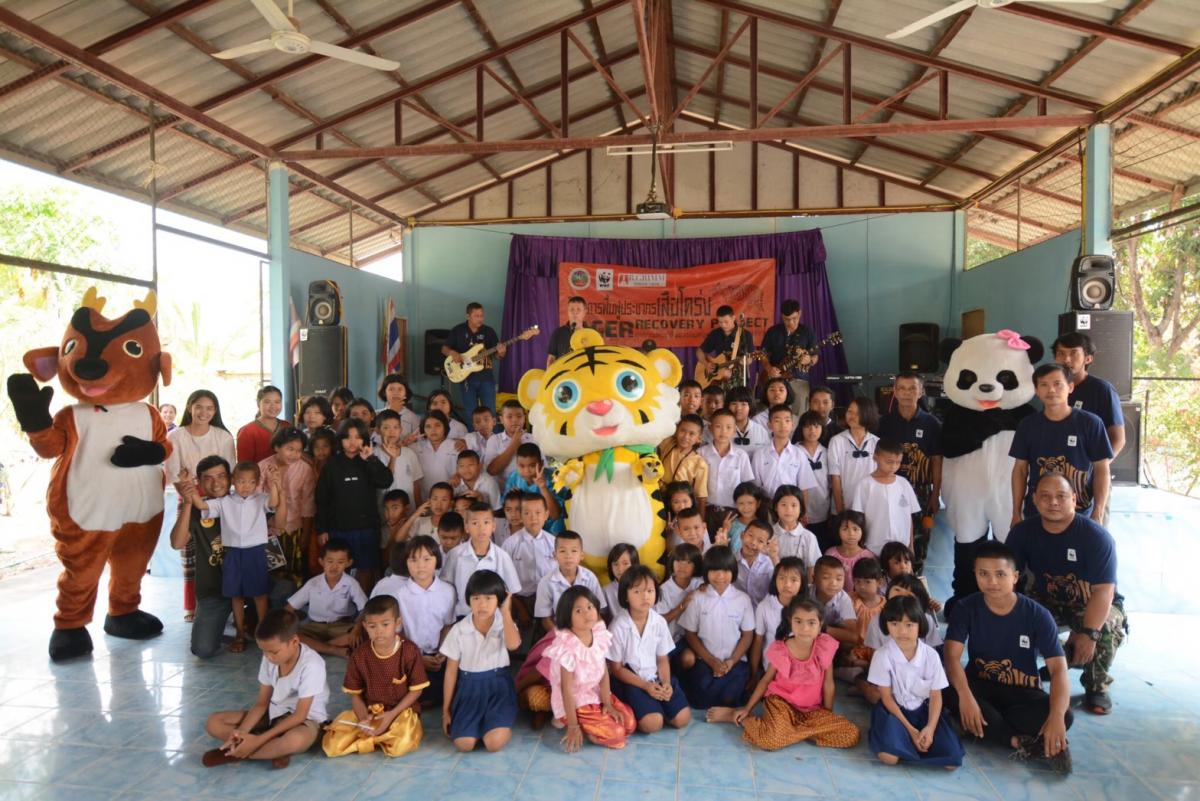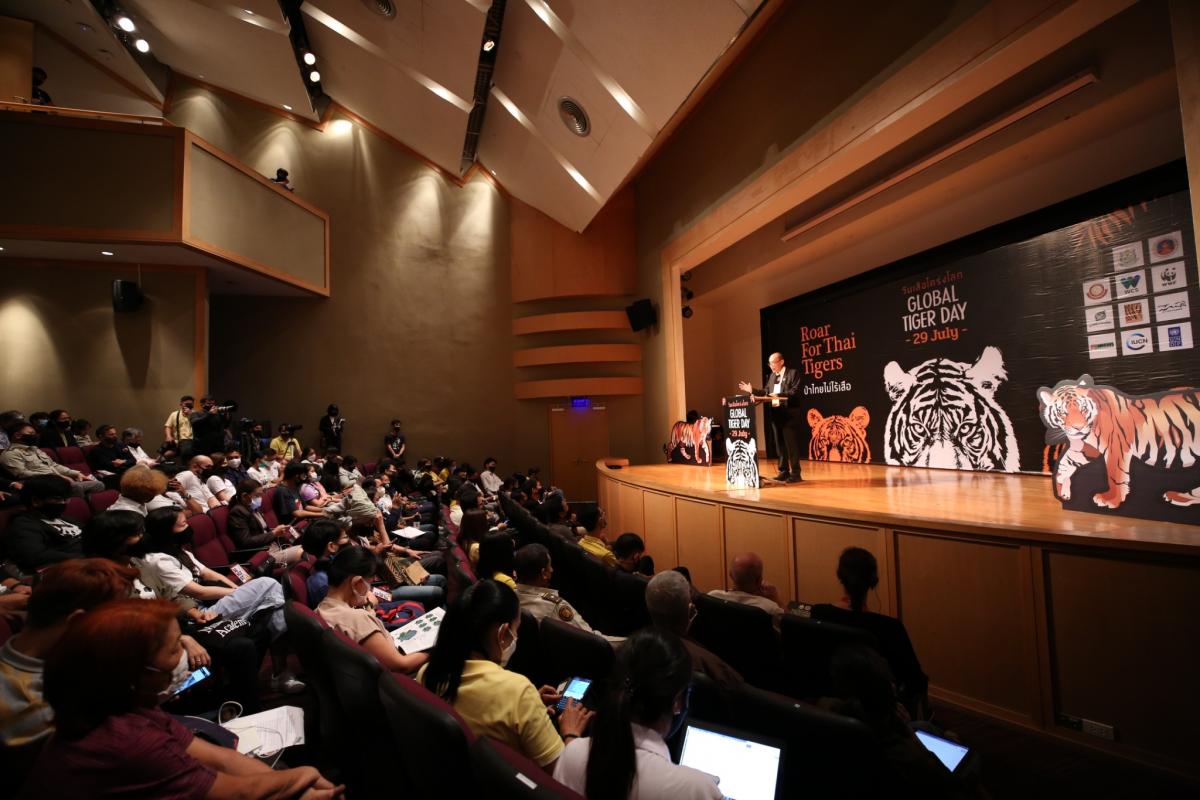The year 2020 was a year filled with challenges. Metropoles became ghost towns, populations learned social distancing, and the world was in a state of emergency.
The Corona-pandemic without doubt is a public health, economic and social crisis of global magnitude. It is simultaneously also the result of an ecological crisis, within which we have found ourselves for decades. When we destroy habitats and subsequently decimate varieties of species, we endanger ourselves. As we disrupt ecosystems and change or destroy them, pathogens seek new hosts - often humans. In many cases, pathogens are transmitted by wild animals. This is increasingly the case, as human to wildlife contact increases resulting from the animals’ search for new habitants nearer human settlements as their natural habitat is destroyed. In addition to habitat destruction, poaching and illegal wild animal trade play a significant role. At least 7,000 wild animal species worldwide are threatened by poaching and illegal wild animal trade.
The good news is that we can choose to prevent pandemics by deliberately supporting animal protection and countering poaching and destruction of natural habitats. Intact ecosystems and healthy wildlife protect us.
News from our Project Region: the Protected Habitat is Growing
The effects of the COVID-19 pandemic were also felt in our project region. Primarily events where larger groups of people meet, e.g. planned game warden trainings and public awareness campaigns in schools and villages could not be conducted in their full measure. Additionally the frequency of illegal forest trespassing tripled, which can be traced back to the increased poverty of the local populace. When humans in the areas neighboring forests lose their main livelihoods, this leads to increased reliance on forest resources. One positive aspect of note is that the regular field work of our game wardens was not affected by the pandemic, and they were able fully to continue their activities protecting wildlife and habitat.
This year, the warden teams countered poachers in even larger areas than the now known Mae Wong, Khlong Lan and Umphang National Parks. Namely the Khlong Wang Chao National Park addition increased the total area for tiger habitat to 4,500 km² (1737 mi²). All four areas that together comprise the “Upper Western Forest Complex” are connected to one another and offer tigers important corridors to other preserves as well in Myanmar, perfect conditions for the tiger habitat. As the population of tigers in Khlong Wang Chao National Park and last year’s new addition Umphang National Park is as yet unknown 100 new camera traps were installed in 50 new locations to obtain a census of tigers and their prey. In total, there are 152 camera traps in the project area that provide valuable information about the tigers, their prey and their migrations throughout the project region.
Map of the Western Forest Complex (© WWF Thailand)
To obtain these important tiger censuses, 145 wardens were trained in assessing camera trap data. The census currently ongoing indicates positive developments. The first assessments have already identified three cubs approximately 5 to 7 months old. Two of the animals are from a female who since 2014 was seen with offspring and now for the third time with cubs, totaling 8 offspring. The third cub is from a female who was first seen in our project region in 2018. This good news indicates that tigers continue to multiply. Moreover, the number of tigers in the neighboring Hua Kha Khaeng Wildlife Sanctuary has increased from 46 to 71 tigers. If the number of tigers in a region increases, then a portion of the population upon achieving a certain maturity migrates away in order to capture new habitat. These are often located in nearby preserves, and the tigers often establish a new population there. If the population in Hua Kha Khaeng continuously grows in this way, then it can be expected that tiger populations in our national parks also continuously increase.


Camera trap photos: Tiger (first row), black leopard and tapir (second row) and elephants and sun bears. All photos were taken in the National Parks in 2020. (© DNP & WWF Thailand)
For the continued protection of tigers, the number of game wardens also increased this year: to the 168 wardens already actively protecting Mae Wong, Khlong Lan and Umphang National Parks, an additional 64 wardens assumed overwatch in Khlong Wang Chao. All wardens were equipped with necessities including uniforms, rucksacks, GPS tools and cameras, and some of them were able to complete training: 51 wardens completed land navigation training, and 40 wardens completed a Smart Patrol training.
On their patrols, the wardens monitored approximately 62% of the 890 km² (343 mi²) large Mae Wong National Park, 77% of the 300 km² (115 mi²) Khlong Lan National Park and 71% of the 720 km² (278 mi²) Khlong Wang Chao National Park. In Umphang, representing by far the largest preserve with 2,600 km², coverage is currently 55%. The objective of the patrols is to cover at least 70% of the overall National Park landmass. Among illegal activities, poaching remains the greatest danger. In addition to seized poacher camps and weapons, sling traps were seized and destroyed. Due to the wardens’ strong presence, no tigers were harmed and poaching of large deer, so important for tiger survival, decreased. Wardens have been so successful in their tiger and prey conservation efforts, that poachers have now resorted to poaching small mammals and birds.




Rangers at a training camp where they learn to assess camera trap data (© DNP & WWF Thailand)
Awareness Campaigns at Universities and Schools: The Future of Tiger Protection
As in earlier years in addition to protecting habitat and wildlife, wardens’ main activities included conducting awareness campaigns in communities and at universities and schools. Tiger protection can only be successful long-term when human populations of local neighboring villages support protective measures, and children and young adults are sensitized to ecology and wildlife protection through university and school programs.
Approximately 1,500 villagers and 450 school children from 7 schools participated in events in which they were taught why tiger protection is so important for humans who live in the region. If we want to protect tigers, we need to preserve a large are in healthy forests. A healthy forest requires clean air and clean water, which in turn is also important for all people. Protecting tigers means protecting the last intact ecosystems of our earth.



Awareness campaigns in villages and schools (© DNP & WWF Thailand)
An additional significant success in building awareness occurred in March 2020. The Faculty of Forestry, Kasetart University was enhanced by the fourth year course “Smart Patrol.” In this new area of study, students are provided the fundamental techniques and methods more effectively to protect against poaching and to protect forests and wildlife. A further element of the new area of study includes practical training whereby students receive training from veteran wardens and participate in Smart Patrol training. Already 100 students were trained successfully last year. What makes this result so significant and unique is that many of the graduates are employed by Thailand’s government and in their new careers oversee implementation of and compliance with nature conservation in Thailand. They are Thailand’s best hope for future governmental nature and wildlife conservationists.
“Roar for Thai Tigers” at the International “Day of the Tiger”
With support from the WWF, the A World for Tigers Foundation , the Wildlife Conservation Society (WCS) and other partners Thailand’s Department of National Parks (DNP) displayed the “Roar for Tigers” tiger conservation exhibit at the Bangkok Art and Culture Center (BACC) from 25 July to August in celebration of the International Day of the Tiger, 29 July 2020.
The event coordinator, the Secretary of Thailand’s Ministry of Natural Resources and Nature Conservation, Pongboon Pongthon, in is opening speech referenced the importance of tigers in intact ecosystems and applauded the cooperation of all participating organizations and their efforts to double the tiger population by the year 2022.
The exhibit displayed important aspects of successful tiger conservation cooperation including:
- Census taking of tigers and their prey,
- Deployment of “Smart Patrol” game wardens,
- Measures to increase the number of hoofed prey as vital tiger resources,
- The threat of construction that limit or destroy tiger habitats,
- The importance of sustainable cooperation of the government with conservation organizations,
- The ecological responsibility of the Thai population and what people can do to support nature and wildlife conservation.
This exhibit does not only contribute to enhancing awareness of Thai society for wildlife and nature conservation but also demonstrates the Thai government’s ecological responsibility for tiger conservation when tigers are understood as extinct in neighboring Vietnam, Cambodia, and Laos.




“Roar for Tigers” tiger conservation exhibit at the Bangkok Art and Culture Center (© DNP & WWF Thailand)
In the future, this exhibit will be displayed in various schools in the form of Tiger Learning Centers. The Anuban Khlong Lan School is the first school in which the opening ceremony of a tiger Learning Center was celebrated on 15 October. The exhibit is available to students of that school as well as local citizens and represents another important component of our awareness campaign effort.
Measures to Improve Tiger Habitat Bear Fruit
So that tiger prey like gaur (the largest bovine), sambar (the largest deer), wild boars and muntjac (small deer) have optimal living conditions in the nature preserve and continuously propagate, it is necessary to create grassland and to establish salt and mineral licks. Of the nine planned grassland areas in Mae Wong and Khlong Lan National parks, the first grassland area was established 2019 in Mae Wong National Park. In 2020, an additional 5 hectare area “Khlong Din Khim” was established 2 km from the first area. Additionally, salt and mineral licks were established in the 10 km² (4 mi²) area “Mae Rewa.” These first measures for improving the habitat, are already bearing fruit: installed camera traps have collected evidence that numerous sambar, muntjac, gaur and elephants have visited the grassland areas and mineral licks.
Gaur, elephant and muntjac visit a newly created grassland area (© all pictures DNP & WWF Thailand)
Efforts to improve the habitat provide an excellent opportunity to include local villagers and students from neighboring villages and in this way to sensitize them to nature and wildlife conservation. At a first event, 50 students and their 4 teachers from nearby schools were invited to help install camera traps and salt and mineral licks. The students enthusiastically supported the effort and learned much about the value of intact forests and ecosystems as well as tiger protection. It is our hope that the students’ enthusiasm for conservationism and learned knowledge will empower them to become “champions for tigers” among their friends and families.






Students distribute salt and minerals to improve the habitat of the local ungulates (© all pictures DNP & WWF Thailand)
We are especially happy that activities of this kind are now well established in the students’ learning plans and will occur regularly. The next visit is already planned during which the next salt licks will be established and by assessing photos from the camera traps identifying which tigers have visited the lick sites.
Tiger Protection On Site: Project Director Rungnapa Phoonjampa
Many people on site are engaged on a daily basis in tiger protection. Among these, a very special role is that of Project Director on site Dr. Rungnapa Phoonjampa, who for several years has worked side by side with wardens to protect tigers. In a short interview, Rung shares insights on what moved her to pursue tiger protection and which successes and challenges she perceives.
our local Project Director Dr. Rungnapa Phoonjampa (© private)
How did you first become interested in tiger conservation and what brought you to the work you are now doing?
In Thailand, tiger is the king of the forest and best indicator of wealthy ecosystem. If tigers can persist, other wildlife species can survive too. Saving tigers and their habitat is very crucial which is not only a benefit for wildlife themselves but also for humankind. So, this reason has inspired me to do this job on tiger conservation project in Thailand where we still have some hope to saving this magnificent species for our planet and next young generation.
Which impact does the Covid-19 pandemic have on the work of the Park Rangers and on the tiger recovery program?
Covid-19 has no impact on rangers in Thailand as they are still working as usual but they take appropriate precautions while working, such as wearing a mask, physical distancing, cleaning their hands often, etc. Regarding the impact to the tiger recovery program – yes. Some activities had to be cancelled or postponed for example ranger trainings, meetings, youth camps and outreach activities in schools and communities.
Looking back at the past years what are the biggest achievements in terms of tiger protection in Thailand?
Thailand has special significance in tiger conservation. Thailand’s government has contributed very much to saving this endangered species. An action plan was established in Thailand for the period 2010-2022. This plan includes themes such as enhanced criminal prosecution of illegal activities, better oversight and protection of the forests and its wildlife, census taking of wildlife, integration of the topic in school teaching plans, awareness campaigns in the population and provisions for financial resources for tiger conservation. Furthermore, the government established close cooperation with local and international partners and nature conservation organizations, from which it receives strong support in tiger conservation. All these activities and investments of the government and all partners make me very optimistic that tigers have a future in Thailand.
What are the biggest opportunities you see for the future of tiger protection in our project area and the goals for the upcoming 1-3 years?
The most important measures are an improvement of the habitat and an increase in the number of prey animals. Only when the number of prey animals is high enough, can the number of tigers increase. These measures simultaneously offer the opportunity to include the local populace by enabling them to serve as examples for establishing grassland areas or protecting prey animals.
Is there anything else important that you would like to share?
Tiger conservation is only possible with the help of many organizations, partners, the local populace and the public. We humans live in the same ecosystem and share the same planet with all other species. It is important that we learn to live in harmony and that we don’t see other species as a threat. Sensitizing humans to the value of wildlife and nature is an important step and the great challenge for longterm nature and tiger conservation.Nothing is impossible if we combine our strengths to protect tigers and their habitat.
With this beautiful message, we thank all our loyal supporters from the bottom of our hearts.– without you tiger conservation would not be possible! Despite all the challenges 2020 posed, we again experienced a positive year in protecting tigers – the number of tigers in Thailand continues to climb!
With the continuous expansion of our protected area, the measures protecting tigers, and the ever increasing integration of the local populations, schools and universities, nothing stands in the way of successful tiger protection in Thailand.
With your help, the A World for Tigers Foundation this year was able to cofinance awareness campaigns for school and university students, the new Tiger Learning Center and the equipping and training of game wardens.
